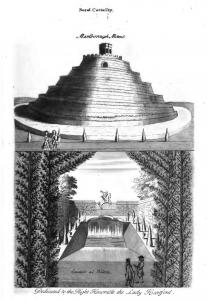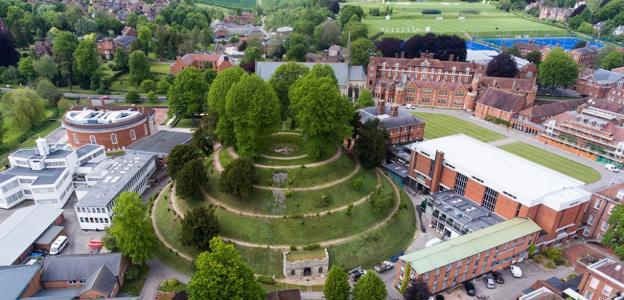River Kennet
River Kennet is in River Thames.
The River Kennet is named after Cunetio, the Roman name for Marlborough, Wiltshire [Map].
3000BC. The Sanctuary [Map] is fifty-eight stone-sockets and sixty-two post-holes forming concentric circles located at the southern end of the West Kennet Avenue on Overton Hill next to the Ridgeway Path. The overall diameter is 40m. William Stukeley reported in 1724 that locals called it The Sanctuary. From The Sanctuary may be seen West Kennet Long Barrow [Map], East Kennet Long Barrow [Map] and Windmill Hill Causewayed Enclosure [Map].
The The Sanctuary [Map] is notable for being where the River Kennet and the Ridgeway Path cross.
Around 3000BC a ring of eight wooden posts 4.5m across with a central post was constructed at The Sanctuary [Map]; possibly a round building.
Before 2800BC the first ring was englarged to 6m and a second ring of eight posts of diameter 11.2m was added to The Sanctuary [Map].
After 2800BC a 21m diameter circle of 33 posts was added, and at the same time an inner stone circle of 15 or 16 sarsen stones was added to The Sanctuary [Map] alongside the now middle ring.
Around 2400BC 42 sarsen stones forming a boundary ring 40m across replaced all the timber structures. Possibly around the same time West Kennet Avenue was constructed.
2400BC. Silbury Hill [Map] is a Prehistoric Mound - the largest in Europe. Around 40m high and 167 meters wide at its base. The summit is flat; 30m wide. No-one knows why it was built. It is at the headwaters of the River Kennet with views east downriver to Marlborough where there is, possibly, another Prehistoric Mound, half the height, next to the River Kennet; the Marlborough Mound. Silbury Hill was constructed around 2400BC. Its construction is complex being a gravel core with kerbs on which alternate layers of chalk rubble and earth. A second phase involved the addition of further chalk.
Avebury by William Stukeley. This town is wrote Aubury, Avebury, Avesbury, sometimes Albury: 'tis hard to say which is the true. The former three names may have their origin from the brook running by, au, aux, water, awy in welsh; the old german aha. The latter points to Aldbury, or old work, regarding its situation within the vallum. Nor is it worth while to dwell on its etymology; the saxon name is a thing of so low a date, in comparison of what we are writing upon, that we expect no great use from it; unless Albury has regard to al, hal, healle, gothicè a temple or great building. There are two heads of the river Kennet rising near it: one from a little north-west of Abury, at Monkton, runs southward to Silbury-hill; this affords but little water, except in wet seasons. At Silbury-hill it joins the Swallow head, or true fountain of the Kennet, which the country people call by the old name, Cunnit; and it is not a little famous among them. This is a plentiful spring. It descends between east and west Kennet, by the temple on Overton-hill, which is properly the head of the snake: it passes by Overton, and so to Marlborough [Map], the roman Cunetio, which has its name from the river.
Colt Hoare 1812. 1812. Plate X. represents the situation of the Temple at Abury, with its two extending avenues; Silbury hill [Map], the principal source of the river Kennet, the British track-way, groups of barrows, and the line of Roman road between Bath and Marlborough. This Plate may be considered as one of the most interesting views which our island can produce. It unites monuments of the earliest British and Roman antiquity, and will, I trust, convey a more correct and explicit idea of Abury and its environs, than any that has heretofore been given. The Plate No. VIII of Stukeley, is both confused and incorrect, because not drawn from actual survey.
Reading [Map] is located where the River Kennet meets the River Thames.
Marlborough Mound [Map] is a probable Prehistoric Mound located at Marlborough School next the the River Kennet. Its base diameter is 83m and a height of 19 meters. Around half the size of Silbury Hill [Map] which is 5.2 miles West upstream on the River Kennet. Curiously Silbury Hill [Map] and the Marlborough Mound [Map] are 5.2 miles apart east to west more or less exactly east to west - a difference of 0.8 degrees.


Marlborough Mound [Map]. Historic England 1005634.
This monument includes a motte castle situated on the summit of a ridge surrounded by a meander of the River Kennet and within the grounds of Marlborough College within a Grade II Registered Garden (2247). The motte survives as a circular mound of up to 85m in diameter and 18m high. Excavations in 1912 found layers of charcoal and antler picks which have long caused speculation as to whether this was a prehistoric earthwork which was re-used as a motte, although a survey in 2001 did not prove the castle to be anything other than medieval in origin. Further excavations in 1936 found the footings for a curtain wall and the buttress for a shell keep on the summit together with 12th to 13th century pottery. Speculation of this having once been part of a much larger castle with baileys was apparently fuelled by the discovery of a V-shaped profile ditch to the north of the motte in 2000 and it has long been believed that much of the bailey extended to the south although the extent of this is not known. In 2005 further excavations indicated the spiral path which winds its way up to the summit was in existence from 1654. Marlborough was part of a royal borough which was visited often by sovereigns, there is no documentary mention of a castle prior to 1138, but it is thought significant that William I imprisoned Bishop Aethelfric of Selsey in Marlborough and that Henry I held an Easter Court there in 1110. Also, several charters were signed in Marlborough which implies the castle did already exist. The first definitive documentary record was in 1139 when it was held by King Stephen from the Empress Matilda. There was further building work during the reign of Henry II which included the 'Great Tower' and continued from 1175 to 1179. King John had the castle repaired and a ring wall built around the motte in 1209-11. Henry III spent £2000 on works between 1227 and 1272 which included work on two chapels, the hall, the keep, two barbicans, a curtain wall, two bridges, gatehouse, and the Queen's apartments. From 1273-1369 it formed part of the Queen's possessions as her 'Dower House'. However, by 1403 it had deteriorated significantly and subsequently remained neglected. Allegedly the black marble font now in Preshute Church came from the castle chapel and was supposedly used to baptise King John and Edward the Black Prince. The winding path, a grotto (listed at Grade II) and a water tower on top of the motte were all landscape garden features from the 17th to 18th centuries. The grotto was originally part of a canal and cascade feature associated with the mound.
Newbury Bridge [Map], also known as Kennet Bridge or Town Bridge, is a bridge over the River Kennet. In 1312, King Edward II directed that the bridge should be kept in good order.
Marlborough, Wiltshire [Map] is on the River Kennet.
Culture, Rivers and River Systems in England and Wales, Thames Estuary, River Thames, River Kennet, River Dun ![]()
The River Dun rises near Great Bedwyn, Wiltshire [Map]. It joins the River Kennet at Hungerford [Map].
Culture, Rivers and River Systems in England and Wales, Thames Estuary, River Thames, River Kennet, River Lambourn ![]()
The River Lambourn rises at Lambourne [Map] from where it flows broadly south-east through Eastbury, Berkshire [Map], East Garston, Berkshire [Map], Great Shefford, Berkshire [Map], Welford, Berkshire [Map], Boxford, Berkshire [Map] to Newbury [Map] where it joins the River Kennet.